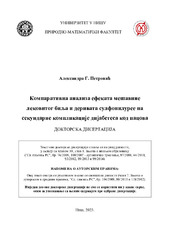Приказ основних података о дисертацији
Komparativna analiza efekata mešavine lekovitog bilja i derivata sulfoniluree na sekundarne imlikacije dijabetisa kod pacova
| dc.contributor.advisor | Đorđević, Ljubiša | |
| dc.contributor.other | Vasiljević, Perica | |
| dc.contributor.other | Zlatković, Bojan | |
| dc.contributor.other | Cvetković, Tatjana | |
| dc.contributor.other | Marković, Slavica | |
| dc.creator | Petrović, Aleksandra | |
| dc.date.accessioned | 2024-04-03T20:02:51Z | |
| dc.date.available | 2024-04-03T20:02:51Z | |
| dc.date.issued | 2023 | |
| dc.identifier.uri | http://eteze.ni.ac.rs/application/showtheses?thesesId=8672 | |
| dc.identifier.uri | https://fedorani.ni.ac.rs/fedora/get/o:2508/bdef:Content/download | |
| dc.identifier.uri | https://plus.cobiss.net/cobiss/sr/sr/bib/138158089 | |
| dc.identifier.uri | https://nardus.mpn.gov.rs/handle/123456789/22409 | |
| dc.description.abstract | Diabetes is a systemic disorder of carbohydrate and lipid metabolism in which chronic hyperglycemia leads to a number of secondary complications such as non-alcoholic fatty liver disease, nephropathy, retinopathy, osteoporosis, and Alzheimer's disease. Standard pharmacotherapy for diabetes focuses on regulating blood glucose levels, but not on the secondary complications that are the most common cause of death in diabetic patients. Therefore, the aims of the study were to evaluate and compare the biological activity of three herbal mixtures with potential antidiabetic activity and to compare the effect of the most effective herbal mixture with the effect of one of the standard antidiabetic drugs - a sulfonylurea derivative - on the secondary complications of diabetes. Comparative analysis of the biological activities of herbal mixtures was evaluated by in vitro tests of antioxidant, antiamylase, and cytoprotective activity and cytotoxicity, while the comparative analysis of the most potent herbal mixture effect and sulfonylurea derivative effect on diabetes and its secondary complications was determined by an in vivo study in a rat model. The results of the in vitro study showed that herbal mixture- I was the most effective one in terms of the highest antioxidant, antiamylase, and cytoprotective activities, as well as a low level of cytotoxicity. HPLC analysis identified 21 polyphenolic compounds in the preparation of herbal mixture-I: catechin and 7 catechin derivatives, p-hydroxybenzoic acid, p-hydroxybenzoic acid derivatives, caffeic acid, chlorogenic acid, chicoric acid, two caffeic acid derivatives, hyperoside, isoquercetin, rutin, quercitrin, isoquercetin, isorhamnetin and a quercetin derivative. The results of the in vivo study showed that the polyherbal mixture-I was non-toxic in long-term use and more effective in regulating blood glucose levels and lipid status of animals, had higher hepatoprotective, nephroprotective, and osteoprotective effects, and great potential in preventing the development of retinopathy and Alzheimer's disease than standard antidiabetic therapy (sulfonylurea derivative and insulin) in a diabetic rat model. | en |
| dc.format | application/pdf | |
| dc.language | sr | |
| dc.publisher | Универзитет у Нишу, Природно-математички факултет | sr |
| dc.rights | openAccess | en |
| dc.rights.uri | https://creativecommons.org/licenses/by-nc-nd/4.0/ | |
| dc.source | Универзитет у Нишу | sr |
| dc.subject | dijabetes, biljna mešavina, hepatoprotektivni efekat, nefroprotektivni efekat, osteoprotektivni efekat, neuroprotektivni efekat, retinopatija | sr |
| dc.subject | diabetes, herbal mixture, hepatoprotective effect, nephroprotective effect, osteoprotective effect, neuroprotective effect, retinopathy | en |
| dc.title | Komparativna analiza efekata mešavine lekovitog bilja i derivata sulfoniluree na sekundarne imlikacije dijabetisa kod pacova | sr |
| dc.type | doctoralThesis | |
| dc.rights.license | BY-NC-ND | |
| dc.identifier.fulltext | http://nardus.mpn.gov.rs/bitstream/id/160642/Doctoral_thesis_15434.pdf | |
| dc.identifier.rcub | https://hdl.handle.net/21.15107/rcub_nardus_22409 |


